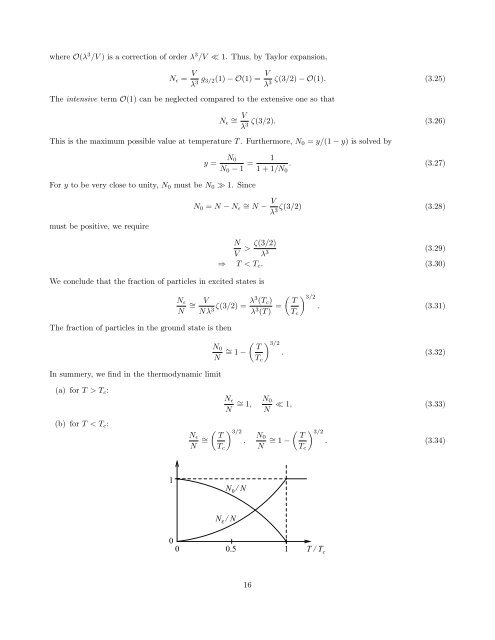Carsten Timm: Theory of superconductivity
Carsten Timm: Theory of superconductivity
Carsten Timm: Theory of superconductivity
You also want an ePaper? Increase the reach of your titles
YUMPU automatically turns print PDFs into web optimized ePapers that Google loves.
where O(λ 3 /V ) is a correction <strong>of</strong> order λ 3 /V ≪ 1. Thus, by Taylor expansion,<br />
N ϵ = V λ 3 g 3/2(1) − O(1) = V ζ(3/2) − O(1). (3.25)<br />
λ3 The intensive term O(1) can be neglected compared to the extensive one so that<br />
N ϵ<br />
∼<br />
V = ζ(3/2). (3.26)<br />
λ3 This is the maximum possible value at temperature T . Furthermore, N 0 = y/(1 − y) is solved by<br />
For y to be very close to unity, N 0 must be N 0 ≫ 1. Since<br />
y = N 0<br />
N 0 − 1 = 1<br />
1 + 1/N 0<br />
. (3.27)<br />
must be positive, we require<br />
N 0 = N − N ϵ<br />
∼<br />
V = N − ζ(3/2) (3.28)<br />
λ3 We conclude that the fraction <strong>of</strong> particles in excited states is<br />
The fraction <strong>of</strong> particles in the ground state is then<br />
N<br />
V > ζ(3/2)<br />
λ 3 (3.29)<br />
⇒ T < T c . (3.30)<br />
N ϵ<br />
N ∼ =<br />
V<br />
( ) 3/2<br />
Nλ 3 ζ(3/2) = λ3 (T c ) T<br />
λ 3 (T ) = . (3.31)<br />
T c<br />
In summery, we find in the thermodynamic limit<br />
( ) 3/2<br />
N 0<br />
N ∼ T<br />
= 1 − . (3.32)<br />
T c<br />
(a) for T > T c :<br />
(b) for T < T c :<br />
N ϵ<br />
N ∼ = 1,<br />
( ) 3/2<br />
N ϵ<br />
N ∼ T<br />
= ,<br />
T c<br />
N 0<br />
N<br />
≪ 1, (3.33)<br />
( ) 3/2<br />
N 0<br />
N ∼ T<br />
= 1 − . (3.34)<br />
T c<br />
1<br />
N / N<br />
0<br />
N / N<br />
ε<br />
0<br />
0<br />
0.5<br />
1<br />
T / T c<br />
16

















